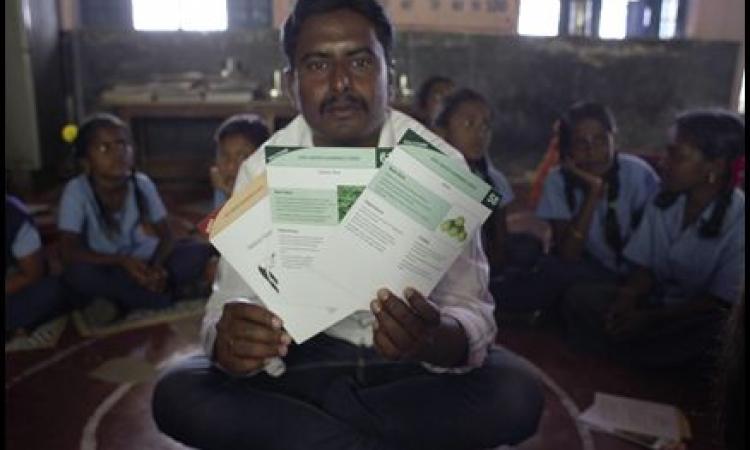
If you are a practitioner, working in the areas of water and sanitation, it is likely that you are building capacities of different people. What if you had a simple but versatile tool that can help build awareness and capacities; that can surface questions and answers and do this for communities, government officials and CSOs?
Impossible? not really, the people at INREM foundation found themselves in this exact position as they have been training and building awareness on complex water quality issues caused by excessive fluoride in water. While trying not only to educate people about problems but also help them with solutions, is when they hit upon the Safe Water Learning Cards idea. These cards are self-learning tools with information on water quality.
Learners use these cards to understand specific topics and learn from each other, in a classroom (both physical and virtual) setting. The cards divide complex safe water topics into basic concepts and practicable solutions. There are totally 72 cards in the water quality set and they are available in several Indian languages.
Safe Water Learning Cards are a hands on tool for continuous engagement and dialogue with people on drinking water quality issues.
Safe Water Learning Cards can be made easily accessible to the Front Line Workers (FLWs), people in rural India, government officials at different levels as well as CSO staff for learning about different water quality issues. Different combinations of cards can be customised for a session based on the target audience. Know more about how the cards are designed for the ‘Fluoride Issue’ in water.
Let’s see how these cards are used by INREM Foundation in a program in Odisha, supported by the EU.
Out of the 72 cards, 28 with basic topics such as What is the fluoride issue? How can we detect it? and What are the possible solutions used? ASHA workers, ANMs, Anganwadi workers and school teachers were the learners who were involved in the deployment of the program.
Anganwadi workers being trained through the Safe Water Learning Cards (Image: INREM)
The outcome was that the anganwadi workers understood the fluoride issue better. They realised that, in some schools, contaminated water was used to prepare meals and because of this, almost 85% of school children were suffering from dental fluorosis. After the session, the anganwadi workers ensured that moringa leaves were added into the dal/curry prepared during the mid-day meals. They had learnt from the cards that moringa leaves, available locally, are highly nutritious and a good nutritional supplement for children suffering from dental and skeletal fluorosis. Community members also started using moringa leaves in their regular meals as well, resulting in lesser joint pain related cases in those gram panchayats.
Sectoral resource
INREM is using these cards to train a wide spectrum of stakeholders - e.g. CSO members, Implementation Support Agencies, Government Officials, Frontline Workers, Individuals, Academicians. INREM has made them openly available to the ecosystem so that others can contextualise and use them across different programs and different stakeholders.
These cards can also be used to support a community-led campaign supported by frontline workers. Know more about how the safe water learning cards can be adopted for training the frontline workers of Jal Jeevan Mission
This is how they went about designing their cards
Digital cards available on Safe water learning app by INREM Foundation
Information around water contamination were classified into 4 sets- Basics, Debates, Strategies and Solutions
|
Set |
Basics |
Debates |
Strategies |
Solutions |
|
Example |
Fluoride standards, testing, identifying type of fluorosis disease, etc. (refer above image: brown coloured card) |
Root causes of fluorosis, The RO debate, Paying for Water, Individual vs Community, etc. |
Collective action, Children as change agents, Village Institutions, Convergence, etc. |
Nutrition garden, Protection of safe water zones, rainwater harvesting, dug wells, etc. (refer above image: green coloured card)
|
- Each card was colour tagged depending on the specific set it belongs to. This makes it easier to identify and mix and match during sessions.Each card was colour tagged depending on the specific set it belongs to. This makes it easier to identify and mix and match during sessions.
- Questions were added to each card, to help stimulate thinking and discussion around that topic.
- Cards are deployed through a facilitator in each training session.
- They also connect the Safe Water Learning Cards to specific digital content through QR codes. Short 1-2 minute audio/video is made accessible from each card through the QR code, which will help enhance knowledge of trainer/trainee.
Source: INREM
Safe water learning cards on water quality management for frontline workers of Jal Jeevan Mission
“Anyone can follow a similar path and design learning cards for topics they train on. They are also welcome to use our cards, and contribute back contextualised ones for building a larger repository”, says Dr. Sunderrajan Krishnan, Executive Director INREM Foundation.
The authors would like to acknowledge and thank Dr. Sunderrajan Krishnan, Kiran Kumar Sen and Shubhoshree Banerjee for their valuable insights.